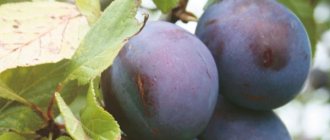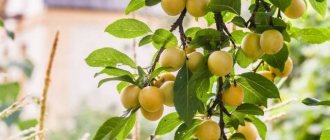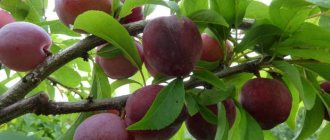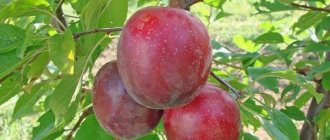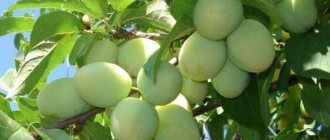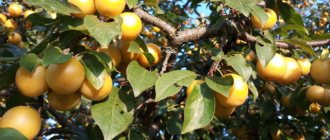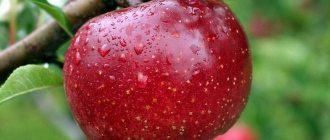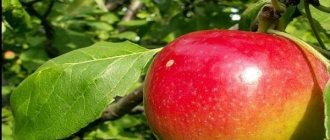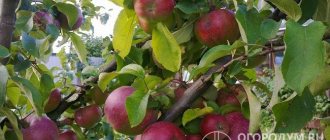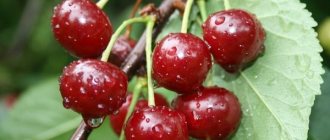Description of the plum variety Angelina
The Angelina plum variety was developed in California. It is late, obtained by crossing Chinese plum and wild quince. The harvest is harvested around the end of September. The tree looks more like a cherry plum and grows up to 3 meters in height. The crown is pyramid-shaped, with a wide base. The pagons are spreading and powerful. The foliage is not very dense, rich green in color. The leaves are oval, pointed at the apex. The buds are white, collected in umbrellas.
Pulp with a high juice content, amber, with a sweet and sour taste
The fruits are almost round, but can also be barrel-shaped. The weight of the cream is 70-90 g on average, although some fruits can reach 120 g. The peel is dark purple with a silver-blue coating. The pulp is high in juice, amber, with a sweet and sour taste. The drupe is not large in size and comes away from the pulp without any problems.
Advantages and disadvantages of the variety
Thanks to its many advantages, the Angelina plum variety is becoming a favorite among gardeners:
- excellent taste of fruits;
- large plum size;
- increased resistance to frost and drought;
- high yields;
- possibility of universal use of fruits.
The disadvantages of the plant include:
- the likelihood of developing diseases due to bad weather;
- difficulty in choosing a suitable pollinator;
- grows poorly in the Black Earth region.
These few shortcomings, as a rule, do not play a special role when planting a tree. In any case, proper care will help avoid many problems when growing.
Characteristics of plum Angelina
Also check out these articles
- Downy goat breeds
- Milking machine Doyushka
- Nubian goats
- Rabbit diseases
The excellent characteristics of the Angelina plum variety have made it a favorite for gardeners in different parts of the world. What makes this variety stand out?
- The first flowering is usually observed 2 years after planting. It falls at the beginning of May. And the first harvest is harvested already 4 years after planting.
- Immunity does a good job of protecting the tree and fruits from most fungal diseases. When pests invade, a tree can withstand their negative effects, but treatment is still necessary.
- The variety adapts well to different weather conditions.
- Plums have commercial quality.
Important!
If a plum is watered very often, it may begin to suffer from fungal diseases.
As pollinators you can take Friar plum, Amber, Black or columnar cherry plum
- Fruits can be transported over long distances. If you harvest the crop on time, it does not wrinkle on the road, the peel does not burst, the natural shine, aroma, and delicate texture of the pulp are preserved.
- The tree is frost-resistant and not afraid of drought.
- High yields are observed annually.
Growing conditions
Plum loves the sun very much, so when choosing a place for planting, you should take into account that there should be no tall plants nearby that will create shade for the young growth, otherwise the seedling will grow slowly. It is also necessary to take into account that the crown of an adult tree is lush and it needs a lot of free space.
Acidic soil is not suitable. If such soil is present, it must be deoxidized by adding dolomite flour or ash. Also, the soil should not be regularly waterlogged. To do this, choose a place where groundwater does not approach the surface closer than half a meter. This plum also does not like strong winds, which is important to consider when choosing a site for planting.
Features of cultivation
You can plant the Angelina variety in spring or autumn, when it is convenient. The place chosen is sunny, sheltered from the wind on one or both sides. The land must be drained and fertile. 1-2 weeks before planting, a hole is made 60 cm deep and 70 cm in diameter. The soil for planting is enriched with humus and minerals. For such a hole, 1-2 buckets of humus and 400 g of superphosphate are enough, and the rest is simple garden soil.
Before planting, a support (peg) is installed in the hole, then a hill is made of fertilized soil, on which the seedling is placed. After the height is adjusted and it stands level and does not lean to the side, you can begin digging in the roots. Having filled the hole, the seedling is compacted with hands, tied to a peg and watered abundantly with water. Now you just need to provide the plum with proper care so that it can fully develop.
- Mulching is not the main, but important part of care. Many gardeners neglect it, but this allows them to reduce the number of waterings, makes the soil more suitable for tree development and destroys weeds in the tree trunk. You can mulch the plum immediately after planting with simple sawdust, decorative mulch or something similar. The mulch layer is 10 cm, for the winter it is increased to 25-30 cm.
- Watering is carried out abundantly. In summer, the ground should be saturated with moisture 40 cm deep, so you need about 5-6 buckets of water for one tree.
- Cleaning the tree trunk circle is very important. From time to time, the mulch is removed to ventilate the ground, weeds are removed, and the soil is dug up.
Cream weight is 70-90 g on average, although some fruits can reach 120 g
Important!
The Angelina plum cannot bear fruit on its own. To get large yields, it is necessary to plant pollinating plums near the variety - plums with the same flowering period as the Angelina variety. As pollinators you can take Friar, Amber, Black plum or columnar cherry plum.
- Fertilizers are applied throughout the year. In the spring, you need to add ammonium nitrate along with watering in an amount of 40 g/square meter. In the fall, you can add 40 g of potassium salt and 80 g of superphosphate to the soil for the same square of planting. But such fertilizers are applied with a break of 1 year. Once every 3 years, the tree is fertilized with humus for digging.
- Pruning is carried out at least once a year. It is necessary to engage in the formation of the tree so that the crown grows neatly, as well as carry out sanitary pruning in order to remove damaged, diseased pagons that interfere with the development of the tree.
- Angelina plum has good winter hardiness. But in order to get large harvests every year, it is necessary to mulch the tree for the winter, and in the northern regions, also cover the trunk.
Landing Features
An important event for every fruit tree, which will further affect its growth and development, is planting. In order to get the maximum amount of harvest with high taste quality and attractive appearance of the fruit, you need to familiarize yourself with the basic recommendations for planting the Angelina plum variety.
Recommended timing
It is better to purchase seedlings in spring or autumn. This time is considered the most favorable for planting based on the high frost resistance of the plant.
Choosing a suitable location
For planting, choose a large and sunny area, since this light-loving plant grows strongly. The land should be well fertilized with organic and inorganic substances. This will promote optimal growth and development of the Angelina plum variety.
What crops can and cannot be planted nearby?
Any tall trees will impede the active growth of the Angelina plum and protect it from the sun. This can slow down the development of the plant and significantly reduce the amount of harvest. Planting nearby apple, pear, raspberry, and black currant trees will have a negative impact on the crop. A maple tree will be a good neighbor for a plum tree.
Selection and preparation of planting material
When buying Angelina plum seedlings, you should pay attention to the root system: it must be carefully packed in film and fertilized with peat, which is necessary for reliable protection from mechanical damage and moisture loss.
How to plant Angelina plum correctly
Planting the Angelina plum variety requires the following actions:
- Dig a planting hole measuring 60 by 70 cm. The root system of the seedling should be placed freely in the planting hole without bending or creasing the roots.
- At the bottom of the hole, lay a composition of organic and mineral elements mixed with fertile soil.
- Form a hill in the center of the hole and place a peg that will serve as a support for the seedling.
- Place the plant to the north of the stake, carefully straightening the roots and covering it with soil.
- Compact the soil well and water it.
- After the moisture has been absorbed, mulch with sawdust.
- At the end of the planting process, securely tie the seedling to a stake.
Diseases and pests
We recommend reading our other articles
- Mandarin Duck
- How and why horses are bred, how to make a business out of it
- Pansy flowers
- Selection of high-quality agricultural feed for animals and poultry
Angelina plum has average resistance to diseases. It can also be attacked by pests, so it is important to know what to do in such cases.
- Rust is expressed as brown spots that form between the veins. Closer to autumn they become darker. From the outside they really look like rust. For treatment, fungicides are used, which can be sprayed on the entire tree or on the affected parts. Prevention consists of treating seedlings before planting and using exclusively healthy plants.
- Chlorotic ringspot is yellow rings and stripes that cover the leaves. Dark spots appear on the fruits. Treatment is carried out only with special equipment, so in small gardens the only way to get rid of the disease is to dig up and burn the tree. But the disease is easy to prevent; it is enough to use healthy, uninfected seedlings for planting.
Photo of the harvest on the Angelina plum tree
- When fruit rot appears, unsightly dark spots appear on the fruit. To prevent this problem, it is important to spray the tree with iodine solution every 3 days. And if the problem has already appeared, the only method of control is to collect the affected fruits and burn them.
These are the main diseases characteristic of the Angelina plum. And now about the pests that can infect a tree.
- Plum moths are caterpillars that eat fruits. To treat, you need to clear the tree of old bark, remove the affected fruits, and then spray the entire tree from the ground to the thin branches with a strong insecticide from a spray bottle. As a preventive measure, you need to promptly rake up fallen leaves and loosen the soil in the tree trunk circle.
- Plum sawfly. It can be seen by the brown spots that appear in summer on the front side of the leaf, and on the back there is a pink coating. The pest can be removed by destroying the affected parts of the plant. For prevention, regular watering, loosening the soil and spraying with insecticides is sufficient.
- Cane aphids can cause severe deformation of tree leaves, which in turn spoils the appearance of the crop, reduces yield and can even lead to the complete destruction of the plum tree. Aphids can be destroyed by spraying with special insecticides or mineral oils.
Exclusive! Plum "Angelino" (autumn variety, late ripening) 1 seedling per package
Angelina plum (Angelino) is a popular variety that is in demand among many summer residents and gardeners who prefer to grow fruit trees. The article discusses the general characteristics of the plant and fruits and offers step-by-step recommendations for planting and caring for a seedling. Helpful tips on pest and disease control are also provided.
Plum Angelina (Angelino)
Angelina plum fruits have a blue coating
The yield indicators of the “Angelina” variety are consistently high
Californian breeders managed to develop the late Angelina variety, obtained by crossing two types of plums - wild and Chinese plums.
The plant in its appearance resembles a cherry plum, but its fruits indicate that it is a plum.
The advantages of this variety include the possibility of universal use and transportation over long distances.
The tree can reach a height of three meters. The crown has a pyramidal shape, the base is wide. Formed from powerful, slightly spreading branches. The tree is characterized by medium density of foliage.
The leaves are elliptical in shape with a slight point at the apex. The flowers are white, collected in ordinary umbrellas. Flowering occurs in early May and begins a year after planting the tree.
The fruits are barrel-shaped or round, large. Some can weigh around 120 g. The average fruit weight is 60-90 g. The pulp is juicy, sweet and sour, amber in color. The peel is dark purple in color and has a blue coating with a slight silver tint. The bone is small and easily separated.
Angelina plum is a variety characterized by increased resistance to most fungal diseases and pests, and also adapts well to unfavorable environmental conditions.
This variety attracts gardeners with its high yield and regular fruiting, which makes Angelina a promising variety. Plum enjoys wide production use in various fields of activity. From one tree it is possible to obtain about 50-80 kg of fruit.
Fruiting occurs annually at the end of September. After planting a seedling in the ground, the harvest begins to form already in the 4th year.
Compared to other plum varieties, Angelina has good resistance to frost and drought. But to ensure high-quality fruiting next year, the gardener needs to prepare the tree for winter and choose the right place for planting.
The plum variety Angelina has only female flowers, therefore, in order to form an ovary on the tree, there must be plants with male or bisexual flowers nearby. In addition, their flowering period must coincide with the flowering of this variety.
Columnar cherry plums and plum varieties Black, Amber, and Friar are suitable as pollinators for Angelina.
This variety has both advantages and disadvantages, but there are more positive aspects. Among the advantages, gardeners note the following features:
- use of fruits for various purposes;
- good taste and external qualities;
- good yield indicator;
- long shelf life;
- resistance to high and low temperatures.
The disadvantages include average resistance to diseases, difficulty in choosing a pollinator and slow plant growth in the Central Black Earth region.
An important process for each fruit tree, which will further affect its growth and development, is planting. To obtain the maximum amount of harvest with good taste and appearance, the gardener must follow certain recommendations for planting plums of this variety.
The plant can be planted in both spring and autumn. Be sure to choose a sunny place, protected from the winds. When planting, take into account the thickness of the crown. The soils are desirable loose, fertile.
Any tall trees will negatively affect the active growth of the Angelina plum and protect the plant from the penetration of sunlight.
This can cause a slowdown in the development of the plant and negatively affect the amount of harvest.
Planting apple, pear, raspberry and black currant bushes next to plum trees will have a negative impact on the crop. For the Angelina variety, maple will be the best neighbor.
When purchasing a seedling, be sure to pay attention to the root system: it should be carefully packed in film and fertilized with peat, which provides reliable protection from mechanical damage and moisture loss.
A few weeks before planting, prepare a planting hole 60 cm deep and 70 cm wide.
To ensure the stability of the seedling, tie it to a stake stuck in the center of the hole. Water the seedling with four buckets of water.
The gardener will not have any difficulties when planting a seedling, but following the recommendations will ensure better plant growth. Follow this pattern:
- Dig a hole and inspect it so that the dimensions correspond to the root system of the plant; it should fit freely in the recess.
- Mix fertile soil with organic matter and mineral elements and place the mixture at the bottom of the hole.
- In the center of the recess, form a hill and place a peg in it to support the plant and protect it from gusts of wind.
- Compact the soil and water thoroughly.
- After the moisture has been absorbed, mulch the seedling with sawdust. You can find more information about proper soil mulching here.
- The last stage is to firmly tie the seedling to the support.
We also recommend reading a detailed article on how to plant and grow plum trees.
Variety care
Caring for the Angelina plum does not require much time or physical effort. For good growth and development, mandatory measures include watering, fertilizing, pruning trees and preparing for winter.
The tree requires constant watering. The soil must be saturated with moisture to a depth of 35-40 cm. At the beginning of summer, more stable watering is required - about 5-6 buckets of water per plant. But you should not flood the tree, since excess moisture can cause the development of fungal diseases.
Fertilizer
Until the plant turns 5 years old, feed it according to the following scheme:
- In the spring. Add 40 g of ammonium nitrate per 1 sq. m.
- In autumn. Fertilize the plant with 40 g of potassium salt and 80 g of superphosphate per 1 square meter. m.
Read more: Cherry Toy variety description
Fertilize every other year. For adult plants, follow the same scheme, but double the amount of fertilizing. Apply organic fertilizers every three years: one bucket of humus.
Tree pruning
Young trees require constant pruning in the summer - this helps speed up fruiting. Already mature plants will need formative pruning, which is considered an easy type of such procedure.
During pruning, the gardener will be able to thin out the crown to avoid thickening, and trim the main ones to stimulate the growth of growing branches. During the fruiting period, be sure to remove diseased, deformed and broken branches. Carry out sanitary pruning every fall.
Anti-aging pruning is carried out only during the period when it is clear that growth has slowed down and the plant produces a small amount of harvest. During the procedure, remove branches that have grown over 3-4 years. Further pruning is carried out after 4-5 years.
Preparing for winter
Preparing for winter begins with compacting the soil around the tree well. If necessary, you can water the plant and fertilize it.
They also paint the tree trunk with lime to avoid damage from severe frosts, spring frosts and severe temperature changes. Mulch the plant with humus.
After the snow falls, form a snowdrift around the tree.
Wrap young plants with burlap or agrofibre - this will provide reliable protection not only from frost, but also from rodents.
The Angelina plum variety is characterized by high resistance to weather changes and low maintenance requirements, but has average resistance to various diseases and pests that can negatively affect yields.
| Disease/Pest | Symptoms | Treatment/Prevention |
| Fruit rot | Dark spots form on the fruits, gradually spreading to all fruits. | For prevention, do not allow mechanical damage to the fruits; spray them with iodine solution every three days. To combat the disease, collect all affected fruits and burn them. |
| Rust | Brown spots with a rusty tint form between the leaf veins. By autumn the spots become darker. | Fungicides that are applied to problem areas will help fight the disease. For prevention, treat the seeds with fungicides before planting or make layering exclusively from healthy plants. Feed trees with microelements. |
| Chlorotic ringspot | Yellow rings and stripes appear on the leaves, and the fruits become covered with dark spots. | As a preventative measure, remove weeds and use healthy planting materials. To combat the disease, disinfection must be carried out only in special laboratory conditions. |
| Plum sawfly | At the beginning of summer, the upper side of the leaves becomes covered with small brown spots, and a powdery pink coating appears on the lower part. | Burning the damaged parts of the plant will help eliminate the pest. For prevention, regularly loosen the soil and water the tree generously during the flowering period. |
| Plum moth | Caterpillars feed on the pulp of fruits, destroying and polluting them with their excrement. This leads to premature ripening of fruits and their falling off. | Prevention consists of timely clearing the area of fallen plums and loosening the soil. Control measures are as follows: clean the tree of dead bark and shake off the affected fruits. Use a chemical sprayer. |
| Cane aphid | When aphids settle in dense colonies on the lower surface of leaves, the pest causes significant damage to the plant. The edges of the leaves curl down and become discolored along the veins. Young fruits infested with aphids are deformed and do not ripen completely. | To get rid of the pest, spray the crown with pyrethroids, insecticides that include nicotine, or mineral oils. |
You can see a complete overview of plum diseases and learn about methods of treating them from our other article, which is located here. Timely elimination of the problem will have a positive effect on the quality and quantity of the harvest.
Collection and storage
- Agro-Market
- Catalog
- Fruit trees
- Exclusive! Unique fruit varieties
Harvest and storage
Angelina plum harvest
The yield from one tree can reach 50-80 kg. The harvest takes place at the end of September. They collect fruits with special devices or manually, climbing a tree using a ladder. After the plums are collected, they need to be processed, sold or stored. At room temperature, ripe fruits can be stored for up to 3 weeks, in the refrigerator or in the cellar for up to 4 months.
Important!
During storage, the taste of Angelina plums, aroma and external qualities do not deteriorate, which is why they are so popular for sale.
Angelina plum fruits have a universal purpose. They can be eaten fresh, used for making desserts and baking. They are also suitable for canning, making juices, jelly, and jam. Often, plums of this variety are used to make sauces and jams, compotes, or simply sealed whole.
Characteristics of the variety
Now let us describe the variety in detail.
“Angelina” is characterized by increased frost resistance: it easily survives temperatures down to -30°C. But disease resistance is at an average level: the tree is often attacked by various pests. Let's give examples and describe how to deal with them:
- Hole spot. This fungal disease can affect branches, buds, foliage, and inflorescences. Appears as brown spots with dark edging. In addition to spots, holes appear on the leaves. The affected fruit changes its shape and stops growing. The disease becomes more active during the spring rains. To overcome the disease, you need to regularly thin out the plum crown, collect fallen leaves and dig up the soil under the tree. All affected branches are cut off and the wounds are treated. If the disease begins to develop strongly two to three weeks after flowering, then the plant must be sprayed with one percent Bordeaux mixture or copper oxychloride at the rate of 30-40 grams per 10 liters of water.
- Gum treatment. This is the most common disease for stone fruit plants. It manifests itself in the form of a thick, colorless or brown or yellow-tinged resin that appears. The substance appears at the site where a branch was cut or where the plant received a sunburn. The diseased branch dries up. The cause of the disease may be an excess of nitrogen and moisture in the soil. To prevent the disease from occurring, you should take more care of the tree and try not to injure it. The wound that appears should be cleaned and treated with a one percent solution of copper sulfate and apply petrolatum. Cut off severely affected branches. After clearing off the dead bark, treat the area with horse sorrel and garden varnish.
- Rust. Another type of fungal disease. It usually becomes active in July. The affected leaves on the outside are covered with voluminous round-shaped spots, similar to rusty ones. They are characterized by an increase in size. A sick tree quickly weakens, loses its leaves early and becomes less resistant to frost. The fight is to use copper chloride for spraying. The solution is prepared at the rate of 40 grams per 5 liters of water. One tree should use 3 liters. This procedure is carried out before flowering. After harvesting, the plant is treated with one percent Bordeaux mixture. With the arrival of autumn, fallen leaves must be constantly removed and burned.
- Fruit rot. Appears in rainy summers. The first manifestations of the disease are noticeable in mid-July. First, mechanically damaged fruits suffer (beaten by hail, eaten by birds). A brown spot appears on the fruit. With high humidity and high temperature, it increases in size. Next, the surface of the fruit is covered with gray-brown “pads”, inside of which there are spores. They are easily blown off by the wind and transferred to other trees.
If affected fruits are found, they should be picked immediately and buried or composted. You need to remove diseased fruits very carefully so as not to touch healthy ones, otherwise the rot will spread to them. To prevent the manifestation of the disease, treat the tree with one percent Bordeaux mixture and carry out intensive control of pests that eat the fruit.
These are not all diseases that can attack a plant, but only the most common ones.
Pollinators
The Angelina plum has only female flowers, so in order for an ovary to form on the tree, there must be plants with male or bisexual flowers nearby. In addition, their flowering period should coincide with the flowering of "Angelina". Suitable pollinators for this tree are: columnar cherry plum, “Black”, “Amber”, “Friar” plums.
"Angelina" bears fruit in its third year. Fruits are formed regularly. The variety has good yield: 50-70 kg per tree. Collection is carried out from the third ten days of September.
This variety has high shelf life. Plums can sit for three weeks at room temperature. In the refrigerator, the shelf life increases to three to four months. Neither the taste nor the form changes.
You can collect unripe fruits, then in the refrigerator they will ripen and taste better. Transportability is also at a high level.
Application
This variety is suitable for:
- fresh consumption;
- freezing (nutrients and taste are not lost);
- preparation of jams, preserves, compotes, liqueurs;
- preparing delicious prunes.
- Angelina enters the fruiting season early - 3 - 4 years after planting;
- flowering occurs late, the harvest ripens in late September - early October, which classifies the variety as late-ripening;
- The yield is regular, gradually increasing every year. From one tree you can get a fairly large harvest - 50 - 70 kg;
- fruits can be picked even at the stage of technical ripeness. They are able not only to ripen perfectly during storage, but also to acquire even higher taste qualities;
- The variety's immunity to fungal diseases is at an average level. There is low resistance of plums to moniliosis; the most dangerous pest is the codling moth;
- Winter hardiness and drought resistance of Angelina are above average;
- According to available information, in the Central Black Earth region the lifespan of a tree is sharply reduced, 2 - 3 years after entering the fruiting period, gum formation, decreased immunity are often observed, and then the death of the plant may occur;
- the transportability of the fruit is high; long-term transportation does not affect the presentation;
- In terms of shelf life, the variety is superior to other types of late plums. In vacuum bags that are stored in the refrigerator, the harvest will remain calm for up to 4 months. In an ordinary basement - about a month;
- The method of consuming fruits is universal. The fruits are very tasty and healthy when eaten fresh and are used to make juices with pulp and jams. In compotes, the skin does not crack, and the flesh remains elastic. The fruits are also used for freezing and making premium quality prunes.
Angelina is self-sterile and requires pollinators. It is advisable to select diploid varieties that bloom at the same time as the described plum. The most suitable options: Traveler, Vixon, Prime Time, Grand Rosa, Friar, Santa Rosa, Ozark Premier.
Reviews of the plum variety Angelina
The Angelina plum is known all over the world. It has a good taste, is easy to grow, and therefore gardeners rarely speak badly of it.
- Oleg Puzik : “I was never a fan of plums, because in childhood all my relatives only grew up Hungarian. But as soon as I tried the Angelina Plum, I decided that it would live in my garden for a long time. The fruits are fleshy, very juicy, and the seed is small. The peel cracks only after it is overripe, and only if you press it down, so I collect it a little ahead of time, so it lasts longer. My wife makes delicious compotes and jams from this plum - in general, I think that this is the most interesting and best variety to grow for yourself.”
- Alexandra Golenko : “My Angelina plum tree is often affected by caterpillars, but if you care for it properly, the fruits will not be damaged. The trees are not difficult to care for; the harvests are large. Most of the fruit is used for sale; the rest of the cream is canned and eaten fresh. The variety is excellent for eating, juicy, sweet, and practically not sour.”
- Sergey Dashko : “For our family, plums are more a source of income than a favorite delicacy, although we close the jam every year. The Angelina variety was chosen for its yield, taste, appearance of the fruit and high demand. It is sold on an equal basis with other varieties at a high price. The trees require care, but they bear fruit as they should, so there are no complaints. I can recommend the variety for those who sell plums.”

